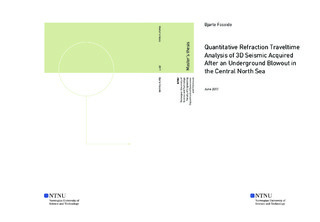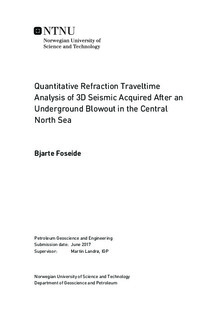| dc.description.abstract | A quantitative refraction traveltime analysis was performed in this thesis. Refraction seismic can be used for monitoring in shallow parts of the subsurface where the contribution from conventional reflection data is inadequate. As the refractions move primarily in the horizontal direction, opposed to the more vertical travel-path of the reflections, they can detect smaller variations below interfaces. One obvious limitation regarding refractions is the requirement of a positive velocity contrast, another is that the deeper events will be influenced by shallower refractions.
An underground blowout in well 2/4-14 in 1989 led to gas migrating into several shallow sand layers, and it was investigated if the traveltime of refracted events could be used to identify and map the horizontal extent of gas accumulations in these layers.
A processing and analysis workflow was successfully established and several refracted events were mapped in a six by six km2 area around the blowout well. The raw seismic data was processed with two different Ormsby bandpass filters, where the lowest frequency filter with limits (2-5-15-20) Hz illustrated best the potential of this method. Numerous refractions at various offsets were initially analysed, but the focus of this thesis is on the most promising and interesting refractions. Results presented are for refractions mapped at two different offsets, 1075 m and 3563 m.
A refraction traveltime anomaly at an estimated depth of 154-176 m was identified and mapped. The refraction traveltime matched the results of a refraction time-shift analysis along a 2D line for data acquired prior to, and 20 months after the blowout. With this, it was interpreted that the shallow refraction traveltime anomaly is caused by gas from the blowout. It is believed that this gas migrated into a tunnel valley and 3 years after the blowout, most of the gas appears to have migrated 800 m SE of the blowout well.
Refraction traveltimes for four refracted events were successfully mapped at a very high offset. They all showed significant anomalies around the blowout well. Two of the refractions are believed to correspond to amplitude anomalies visible in reflection seismic and the other two possibly shows gas anomalies not visible in the reflection data. The fact that the refraction traveltime anomalies also are more well defined illustrates some advantages with using refractions to map the shallow subsurface.
The results in this thesis demonstrate a way to use refraction traveltimes as a method of mapping the shallow subsurface. Despite the limitations, gas in several sand layers from the underground blowout were successfully identified and mapped. | |

